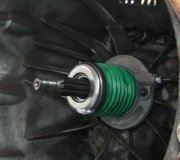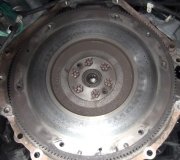Hold on. You are getting "wrapped around the axle" with a lot of misinformation. First of all, the diagnostic fault codes did not say to replace parts. They never do. Fault codes only indicate the circuit or system that needs further diagnosis, or the unacceptable operating condition. When a part is referenced in a fault code, it is actually the cause of that code about half of the time. First you have to rule out wiring and connector terminal problems and mechanical problems associated with that part.
The second concern is you know two sensors did not fail at exactly the same time. You need to list the exact fault code numbers, then we can determine if a properly-working sensor is simply reporting a defective condition. In this case, if internal slippage is taking place, the Transmission Computer knows that by the discrepancy between engine speed, (input speed sensor), road speed, (output speed sensor), and the programmed-in gear ratio of the current gear the transmission is in.
Next, you bounced to a solenoid but you have not listed a fault code related to that. If there was an electrical problem, as in an open coil, corroded connector terminal, cut wire, etc, that would be detected by the Transmission Computer as soon as you turned on the ignition switch. The computer would immediately set the appropriate fault code and put the system into limp mode. You would start out in second gear and it would stay there. You would not be able to drive normally for a mile.
The same is true for a failed speed sensor. A break in the circuit would be detected right away, and it would go to limp mode right away.
You would get entirely different fault codes if there was a mechanical problem associated with a sensor or solenoid. For example, suppose metal filings collected on the tip of a speed sensor. That would reduce its ability to magnetically generate a signal. That signal would get weaker and weaker until it got to the point where it was too weak to be read by the computer. That could potentially cause the symptom you described, but it is unlikely it would be so consistent. The fault code would refer to a missing signal, not an electrical problem with the wiring. Electrically everything would be fine, so no defect would be detected when you turned on the ignition switch. The defect would be detected after driving a while. Also, since anything generated magnetically, including magnetic sensors, alternators, generators, etc, become less efficient at lower speeds, a speed sensor signal weakened by metal filings would drop out to the point the computer couldn't read it when you were slowing for a stop. That is why some systems go into limp mode when you are slowing down.
You can also get a fault code related to mechanical problems with a solenoid. The computer knows it turned on a specific set of solenoids for the desired gear, then it expects to see a corresponding change from a pressure switch confirming the solenoids activated. If it sees no electrical problems with the solenoids but not the expected pressure change, it sets a code referring to a hydraulic problem related to one of the solenoids. That code is quite different than one referring to an electrical problem. In fact, there is always a long list of conditions that must be met for a fault code to set, and in this case, the computer knows that if there's an electrical problem with a solenoid circuit, there is no way it can expect that solenoid to work, and no way it should expect to see a pressure change. Once the code is set for the electrical problem, it will not allow a code to be set for the corresponding hydraulic problem.
My suspicion is the code you have relates to a speed mismatch between the input and output speed sensors. That is due to slippage in one of the clutch packs, and most commonly that is detected during a low-acceleration up-shift. Decades ago, before Chrysler invented the computer-controlled transmission, they were hydraulically-controlled, and clutch plate wear resulted in slight slippage during up-shifts. That gradually got worse over the life of the transmission, and we would see that as "engine runaway", meaning the engine speed would increase noticeably for one or two seconds until the next clutch pack locked up. We had one or two years of warning that a rebuild was in our future.
One of the innovations with Chrysler's design was the computer learns the amount of clutch plate wear by measuring the volume of fluid it takes to apply each clutch pack. Knowing that, it will apply third gear, for example, a little sooner before it releases second gear. That results in a nice crisp shift, like when it was new. The problem is there is a limit to how much it can update that shift overlap. The wear is taking place just like it did with the older transmissions, but the drawback is you do not notice the gradual increase in slippage, until the day comes when it can't update enough. That is when the slippage is detected and the computer puts the system into limp mode. To get it out of limp mode you must turn the ignition switch off, then restart the engine.
It is important to understand the difference between the fault code descriptions. If the input speed sensor is involved with the problem, you will get a fault code related to an electrical problem associated with that circuit, OR a mechanical problem related to a missing signal. The same two possibilities exist for the output speed sensor. The code for mismatched speed signals is due to mechanical slippage in a clutch pack, and it can only be set by reading the two signals from two properly-working sensors. You do not replace sensors when they are providing information you do not like.
There are two things you need to do at this point. The first is to list the exact fault code description. The second, since this could be related to clutch pack wear, is to have your mechanic use a scanner to read the "clutch volume index", CVI. That is a set of four numbers correlated to the volume, in CC's, of fluid it takes to apply each clutch pack. Based on those numbers, an experienced transmission specialist can tell you what percentage of life can be expected to be remaining in each clutch. Based on this information, I should be able to direct you to a better course of action.
Tuesday, November 22nd, 2016 AT 3:02 PM


